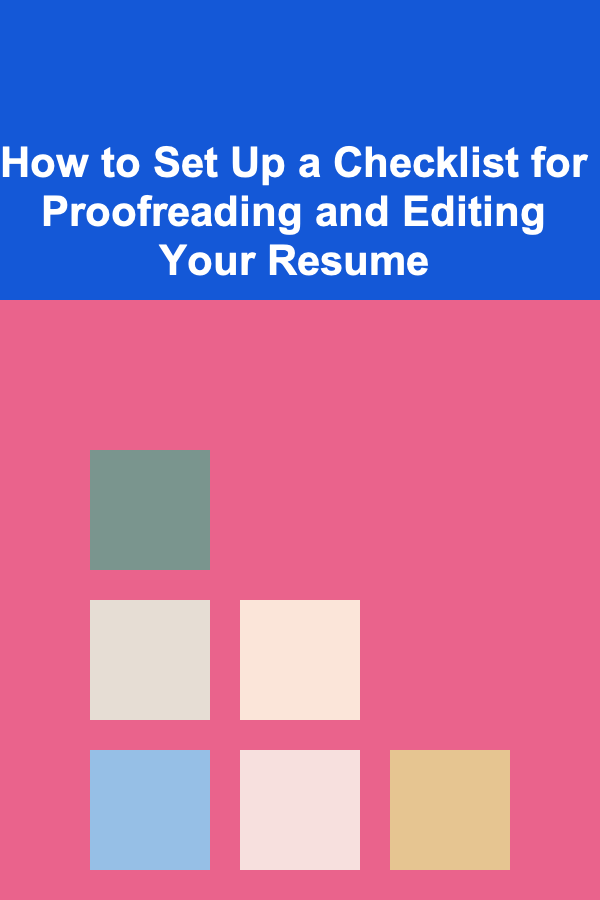
How to Set Up a Checklist for Proofreading and Editing Your Resume
ebook include PDF & Audio bundle (Micro Guide)
$12.99$6.99
Limited Time Offer! Order within the next:

When applying for a job, your resume serves as your first introduction to a potential employer. It's a representation of your skills, qualifications, and professional history, and it must be impeccable. Even a minor error or omission can make the difference between getting an interview or having your resume overlooked. That's why proofreading and editing your resume thoroughly is a crucial step in the job application process.
Creating a checklist to guide your proofreading and editing process will help you ensure that your resume is polished, clear, and free from any mistakes that could undermine your candidacy. This actionable guide walks you through how to set up a detailed proofreading and editing checklist to refine your resume.
Start with the Basics: Formatting and Structure
The first step in proofreading and editing your resume is checking the overall structure and formatting. A resume should look professional, easy to read, and well-organized. Recruiters typically spend only a few seconds scanning each resume, so ensuring clarity and accessibility is paramount.
1.1 Consistency of Formatting
- Font Style and Size: Ensure that the font style and size are consistent throughout your resume. Common choices for resume fonts include Arial, Calibri, and Times New Roman. Use a size between 10 and 12 points for body text and slightly larger sizes for headings.
- Margins and Spacing: Double-check your margins to ensure they are consistent (usually set to 1 inch). Adequate white space between sections (such as 1.15 to 1.5 line spacing) will help the reader navigate through your document without feeling overwhelmed.
- Bullet Points and Indentation: If you're using bullet points to list achievements or responsibilities, make sure they are aligned and consistent in style across the entire document. Don't mix between dashes, circles, or squares unless you have a clear rationale for doing so.
- Headings and Subheadings: Ensure that the headings for each section (e.g., "Work Experience," "Education," "Skills") are uniform in style and position. Typically, headings should be bolded or capitalized for easy navigation.
1.2 Section Layout and Flow
- Logical Order: Arrange sections in a logical order: typically, "Contact Information," "Summary," "Work Experience," "Education," "Skills," and any additional sections like certifications, languages, or volunteer experience.
- Avoid Overcrowding: Ensure that your resume isn't overcrowded with text. White space is your friend. If your resume feels too cramped, consider adjusting the margins or reducing font size slightly.
Content Review: Accuracy and Clarity
Once the formatting is in order, the next step is to dive into the content of your resume. This is where you'll ensure that your qualifications, achievements, and skills are presented clearly and correctly.
2.1 Proofreading for Grammar and Spelling Errors
- Spelling Mistakes: Carefully proofread your resume for common spelling mistakes. Even small errors, such as typing "recieve" instead of "receive," can create a negative impression.
- Grammar Consistency: Ensure that your resume uses proper grammar throughout. For example, check that your verb tenses are consistent---use past tense for previous jobs and present tense for your current position.
- Subject-Verb Agreement: Double-check for subject-verb agreement. For instance, "She manage" should be corrected to "She manages."
- Use of Articles and Prepositions: Ensure articles (a, an, the) and prepositions (in, on, at) are used correctly. These small words can be easily overlooked but are essential for clarity and flow.
2.2 Clarity and Precision
- Conciseness: Ensure that each section of your resume is concise, removing any unnecessary words or phrases. For example, replace "Responsible for managing a team of five individuals" with "Managed a team of five."
- Avoid Jargon: Avoid industry jargon or overly complex terminology that might confuse the reader. Stick to terms and language that are universally understood.
- Focus on Results: Emphasize accomplishments, not just job duties. Use action verbs and quantifiable achievements. For instance, "Improved sales by 20% in six months" is much more impactful than "Responsible for improving sales."
Check for Consistency and Relevance
Ensuring that your resume content is consistent and relevant to the position you're applying for is essential. A resume should reflect a coherent narrative of your qualifications and experiences while aligning with the job you want.
3.1 Consistency in Terminology and Dates
- Job Titles and Company Names: Double-check that job titles and company names are spelled correctly and consistent throughout your resume. Ensure that you use the same formatting for each job title (e.g., capitalization and abbreviations).
- Dates: Confirm that your employment dates are accurate and presented consistently. Use either month/year or just years, but avoid mixing both formats. For instance, if you use "January 2020 - March 2021" for one job, don't switch to "2020--2021" for another.
3.2 Relevance to the Job
- Tailor Your Resume to the Role: Adapt your resume to the specific job you're applying for. This includes tweaking your summary, skills section, and even some job descriptions to reflect the qualifications and keywords in the job posting.
- Eliminate Irrelevant Information: Remove outdated or irrelevant experiences that don't contribute to your current career goals. For example, if you're applying for a marketing position, your job as a part-time cashier from 10 years ago might not be necessary.
3.3 Highlighting Relevant Skills
- Skills Section: Make sure your skills section reflects the key competencies that are most important for the job. Use the language found in the job description for a better match, especially when it comes to technical skills and qualifications.
- Soft Skills: While soft skills such as communication, leadership, and teamwork are important, make sure to provide concrete examples or outcomes that demonstrate these abilities, rather than just listing them.
Final Touches: Design, Length, and Clarity
Once you've reviewed the content and ensured it is accurate, clear, and relevant, it's time to focus on the finishing touches. These last steps will make your resume stand out and ensure that it leaves a lasting impression.
4.1 Design Considerations
- Avoid Overuse of Colors and Graphics: While adding a splash of color or a graphic element might make your resume more visually appealing, it's important not to overdo it. Stick to a clean, professional design that highlights the content without distracting from it.
- Use of Section Dividers: Consider using simple lines or bold headings to divide sections. These separators can make your resume easier to read and give it a more polished appearance.
4.2 Check for Length
- Keep It Concise: Ideally, your resume should be one page long if you have less than 10 years of experience. For those with more extensive experience, two pages are acceptable. If your resume is longer, consider trimming unnecessary details.
- Avoid Clutter: Avoid long paragraphs and dense blocks of text. Each section should be clear and easy to scan quickly.
4.3 Read It Aloud
- Read Your Resume Aloud: This often overlooked technique can help you catch awkward phrasing or errors that your eyes might have missed. Hearing the text helps identify areas that sound off or require rewording.
Get a Second Opinion
Even after carefully proofreading and editing your resume, it's always a good idea to have someone else review it. A second set of eyes can catch errors you might have missed and provide valuable feedback on how your resume is perceived. Ask a friend, family member, or professional mentor to look it over.
Proofreading Tools to Help
You don't have to proofread and edit your resume alone. There are several tools that can assist you in this process:
- Grammarly: A tool that can help you check for spelling, grammar, and punctuation errors. It also offers suggestions for improving clarity and style.
- Hemingway Editor: A writing assistant tool that helps you identify complex sentences and areas where you can simplify your language.
- ProWritingAid: An all-in-one tool for grammar checking, readability analysis, and more.
- Microsoft Word's Built-in Spell Checker: Though not perfect, it's a useful first step for catching basic spelling and grammar errors.
Conclusion
Creating a checklist for proofreading and editing your resume is an essential part of ensuring your job application is as strong as possible. By focusing on formatting, content accuracy, relevance, and design, you will create a resume that stands out to recruiters and hiring managers. Additionally, using tools and getting feedback from others can help refine your resume even further. With attention to detail and a clear, polished presentation of your skills and experience, you'll be one step closer to landing that dream job.

How to Store Extra Bedding and Towels Without Taking Up Room
Read More
How to Train Your Dog for Home Security
Read More
How to Build a Stronger Digestive System
Read More
Exploring Nanotechnology in Everyday Life: A Deep Dive
Read More
How to Plan Your Job Search for Government Jobs
Read More
10 Powerful Bible Verses for Financial Blessing
Read MoreOther Products

How to Store Extra Bedding and Towels Without Taking Up Room
Read More
How to Train Your Dog for Home Security
Read More
How to Build a Stronger Digestive System
Read More
Exploring Nanotechnology in Everyday Life: A Deep Dive
Read More
How to Plan Your Job Search for Government Jobs
Read More